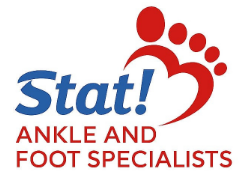Hammertoe is a condition where one or more of the toes become bent at the middle joint, resembling a hammer-like shape. It often affects the second, third, or fourth toes and can lead to pain, difficulty walking, and discomfort when wearing shoes. At StatPodiatry, we specialize in diagnosing and treating hammertoe to restore the natural function and comfort of your feet.
What Causes Hammertoe?
Hammertoe develops when the muscles and tendons in the toe become imbalanced. This leads to the toe being permanently bent. Some common causes of hammertoe include:
- Wearing Tight Shoes: Shoes with a narrow toe box or high heels can put pressure on the toes, causing them to bend over time.
- Genetics: Inherited foot structure issues, such as high arches or flat feet, can increase the risk of developing hammertoe.
- Injuries: Trauma to the toe, such as stubbing or twisting, can cause damage to the tendons and joints, leading to hammertoe.
- Arthritis: Conditions like rheumatoid arthritis can weaken the toe joints, contributing to the development of hammertoe.
- Imbalance in Foot Mechanics: Conditions like flat feet or high arches can alter the natural alignment of the toes, increasing the likelihood of hammertoe formation.
Symptoms of Hammertoe
Common symptoms of hammertoe include:
- A bent or curled toe: The affected toe may appear bent at the middle joint.
- Pain and discomfort: Especially when wearing shoes that put pressure on the bent toe.
- Swelling and redness: Around the joint of the affected toe.
- Corn or callus formation: Hard skin that forms due to friction from shoes.
- Limited movement: Difficulty in straightening the affected toe.
Treatment Options for Hammertoe
At StatPodiatry, we offer a range of treatments for hammertoe depending on the severity of the condition:
- Conservative Treatments:
- Padding and Cushioning: Soft pads can be placed on the toe to reduce friction and pressure.
- Proper Footwear: Shoes with a wide toe box and low heels can help reduce the pressure on the toes and alleviate discomfort.
- Stretching and Exercises: Toe exercises can help stretch and strengthen the muscles, improving toe alignment.
- Orthotics: Custom-made insoles can provide better foot support and correct abnormal foot mechanics contributing to hammertoe.
- Medications: Nonsteroidal anti-inflammatory drugs (NSAIDs) can help reduce pain and swelling associated with hammertoe.
- Surgical Treatment: If conservative treatments fail to relieve symptoms, surgery may be recommended. Procedures such as toe tendon release or joint fusion can correct the deformity and restore normal toe function.
Why Choose StatPodiatry for Hammertoe Treatment?
At StatPodiatry, Dr. Abad Majeed DPM offers expert care for hammertoe, using both conservative and surgical treatments tailored to your needs. We aim to provide effective solutions to restore the health and comfort of your feet.
Convenient Locations
Visit StatPodiatry to get specialized care for hammertoe:
- Schaumburg, IL – 847-301-1212
- Park Ridge, IL – 847-904-7400
- Arlington Heights, IL – 847-392-7400
Get Relief from Hammertoe
If you’re suffering from hammertoe, contact StatPodiatry today to schedule an appointment with Dr. Abad Majeed DPM. We are here to help you find relief and restore the natural function of your toes.
